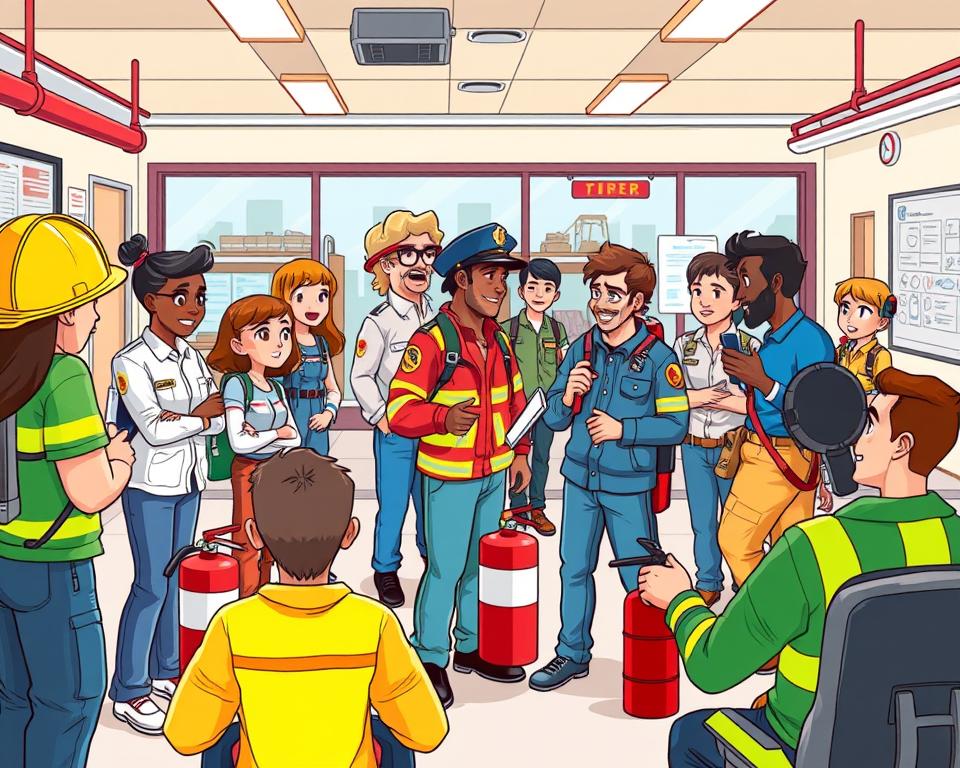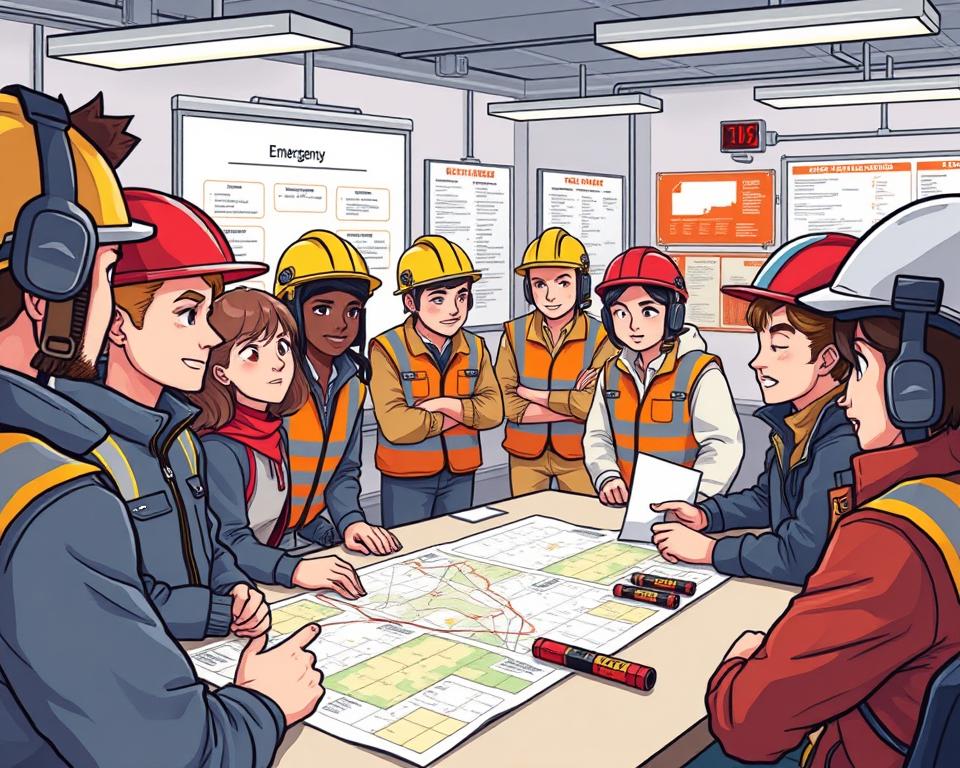At Spire Safety Consultants Australia, we often encounter businesses that underestimate the gravity of fire safety compliance and training. However, emergency preparedness is not just a legal requirement; it’s a fundamental aspect of ensuring the safety and continuity of any Australian organisation. And when it comes to syncing with the stringent Australian fire safety standards, are you aware of how well-equipped your team is?
Our specialised online fire safety training aligns with Australia’s AS3745-2010 and pertinent State and Territory legislation. We’ve designed it to be completed at your convenience, anytime, through our website. Staying compliant doesn’t have to disrupt your business productivity, especially with our comprehensive General Fire Safety Course—each tailored to certify your team in just 20-40 minutes through a personalised learning portal.
Remember, preparing for emergencies is not just about ticking boxes; it’s about embedding consciousness and responsibility for fire safety within your team’s ethos. With our user-friendly courses accessible via Google Chrome, your organisation can take significant strides towards comprehensive emergency preparedness and fire safety compliance. Are you ready to take that step with us today?
Understanding the Essentials of Fire Safety Compliance
Ensuring comprehensive fire safety compliance is not only a legal obligation but also a fundamental aspect of risk management and workplace safety in Australia. Adhering to established fire safety regulations and standards safeguards both property and lives. In this context, our focus aligns sharply with enhancing fire prevention, conducting regular fire drills, and refining emergency procedures within organizational settings.
The Role of Australian Standards
In accordance with the Australian Standard AS3745-2010, our training programs are meticulously designed to address the exigencies of emergency situations in facilities. This Standard mandates the establishment of appropriate emergency procedures, including the execution of fire drills and the maintenance of fire suppression equipment. Our curriculum integrates these requirements seamlessly, ensuring that all participants are well-versed in the tactical aspects of fire safety.
State and Territory Fire Safety Legislation
Fire safety legislation varies significantly across different states and territories in Australia. Each jurisdiction may augment the baseline requirements set by national standards with additional, region-specific regulations. Our training programs take these variations into account, ensuring that your organization remains compliant not only at a federal level but also within your specific territorial legal framework. We emphasize practical training elements such as the effective use of fire extinguishers, fire blanket deployment, and the strategic execution of fire emergency evacuations.
Integrating these stringent fire safety regulations into daily operations significantly amplifies the ability of an organization to manage emergencies effectively. Through our comprehensive training modules, we ensure that your team is not only prepared theoretically but has practical, hands-on experience in handling real-life fire scenarios efficiently and safely.
Key Components of Fire Safety Training Programmes
Understanding and executing fire safety procedures in workplaces are paramount for safeguarding lives and property. Our meticulous courses are designed to enhance the efficacy of fire response strategies and promote widespread awareness. Detailed below are the core elements of our fire safety training modules, pivotal to fostering a culture of safety and preparedness.
- Fire Extinguisher Training: Crucial for every employee, our training encompasses the types of fire extinguishers, their uses according to different classes of fire, and hands-on practice to ensure confidence in handling live fire situations. This segment empowers each participant with the knowledge to tactically extinguish incipient fires.
- Fire Safety Inspections: Regular inspections play a critical role in fire prevention. Through these, staff learn to identify potential fire hazards and address them proactively. Inspection training includes checking safety equipment, ensuring clear evacuation paths, and compliance with fire safety regulations.
- Fire Risk Assessments: We prioritize training individuals to perform thorough risk assessments—an integral process that involves the identification, evaluation, and mitigation of fire risks in the workplace. This includes educating staff on recognising fire hazards and implementing preventive measures.
Each course is carefully structured to ensure comprehensive coverage of all necessary safety protocols and legal compliance, aiming to prepare individuals and teams to face any fire-related emergencies competently.
We believe, through regular training and rigorous inspections, fire safety becomes a natural part of an organisation’s operation, significantly reducing the likelihood of fire incidents and enhancing overall safety.
Furthermore, integrating practical components like mock drills and live demonstrations ensures that knowledge is not only gained but also applied. It is not just about passing a course but developing a robust, practical understanding of fire risk assessments and response strategies. Ensuring everyone’s well-being is, and always should be, a top priority.
Conclusively, our programmes are more than just regulatory compliance; they are about creating a secure, knowledgeable work environment capable of confidently dealing with emergencies. This commitment to comprehensive fire safety education sets the foundations for a safer workplace.

Advanced Training: Roles and Responsibilities within an Emergency Control Organisation
In the realm of fire safety and preparedness, establishing a robust emergency control organisation (ECO) is crucial. This group of highly trained individuals is essential for initiating effective emergency responses, including fire evacuation plans, within any organisation.

At the pinnacle of the ECO hierarchy is the Chief Warden, whose training is intensive and central to successful emergency leadership. Chief Warden training equips individuals with the skills needed to manage not only the overall crisis response but also to coordinate with emergency services efficiently. This role is intricately detailed to include leadership during turbulent times, ensuring that all safety protocols and evacuation strategies are followed meticulously.
Chief Warden and Deputy Chief Warden Training
The rigour in Chief Warden training reflects the gravity and complexity of the responsibilities handled by these professionals. Not just about calling the shots during an emergency, a Chief Warden’s role is also about proactive engagement in crafting actionable fire evacuation plans that cater to the specific needs of the facility. Additionally, their deputies, trained equally for these exigencies, must be prepared to take over at a moment’s notice, ensuring continuity of command.
Communication Officers’ Duties in Emergencies
Communication officers form the backbone of any emergency communication strategies. These individuals are trained extensively to handle emergency communication tools, maintain logs, and ensure that vital information is relayed without error to all relevant parties during a crisis scenario. Their role is critical in keeping the lines of communication clear, aiding in the seamless execution of evacuation plans and ensuring that all personnel are kept informed of developments.
Underpinning these training programs is the expertise of seasoned fire safety advisers who ensure that all aspects of the training are up-to-date and comply with the latest safety standards. Their knowledge and experience in emergency management and firefighting techniques form the bedrock of high-quality training that empowers Chief Wardens and their teams to act decisively and effectively.
Ultimately, the success of an emergency response within any organisation depends heavily on the systematic training provided to its ECO. Regular updates and drills are essential components of this training, preparing the team for a variety of emergency situations, ensuring that when the need arises, the emergency control organisation operates like a well-oiled machine, ready to tackle challenges head-on.
Fire Safety Compliance and Training for Specific Industries
Understanding the diverse needs of industries when it comes to fire safety compliance is critical. Industries vary greatly in their risk profiles and operational environments, necessitating tailored approaches to fire safety training and emergency planning. We delve into how specific industries can better integrate fire alarms systems, adhere to fire safety legislation, and enhance their emergency planning capabilities.
- Fire Alarms Systems: Essential for early detection and response, fire alarms systems need to be adapted to the specific environmental conditions and risks of industries such as mining, healthcare, and manufacturing. For instance, high dust environments like mining may require more robust and sensitive systems to prevent false alarms.
- Emergency Planning: Effective emergency planning varies by sector. For example, high-rise buildings have distinct egress challenges compared to sprawling industrial complexes. Tailoring drill practices and evacuation procedures to the architecture and workforce size is crucial.
- Fire Safety Legislation Compliance: Different sectors must navigate varying layers of legislation. While general compliance might cover most scenarios, industries like petrochemicals and pharmaceuticals face additional regulatory scrutiny, which may demand higher fire protection standards.
- Roles of ECO and EPC: Effective management of fire emergencies hinges on clearly defined roles within the Emergency Control Organisation (ECO) and the participation of Emergency Planning Committees (EPC). These roles must be understood and practiced regularly through drills and education sessions.
In every case, the integration of advanced technology and systems in training such as virtual reality (VR) for fire safety drills and medical simulations can greatly enhance preparedness and response times. In industries where rapid reaction is crucial, such as in oil and gas, leveraging these technologies can be particularly beneficial.
To support this, our approach includes comprehensive training sessions that cover both theory and practical applications. This ensures that all personnel, irrespective of their role, are equipped not only to prevent fires but also to handle an emergency effectively should one arise. From routine fire safety audits designed to identify potential hazards to custom training modules aimed at different sectors, our objective is to cater effectively to the unique demands of each industry.
Ultimately, ensuring that each employee understands their role in fire safety and emergency response is not just about meeting legal obligations—it’s about fostering a safe working environment. By adopting industry-specific fire safety training and compliance measures, businesses can significantly mitigate risks and enhance their operational integrity.
Cost-effective Fire Safety Training Solutions
As we navigate the complexities of ensuring the safety and compliance of businesses across Australia, the significance of sourcing cost-effective fire safety training services becomes all too clear. In today’s fast-paced market, accessibility to quality, budget-friendly fire safety solutions is crucial. With a service span that has thus far benefitted over 16,581 clients, we’ve devised tailor-made packages that ensure businesses remain vigilant and compliant without imposing excessive financial burdens.
General Fire Safety Courses for Employees
We support Australian businesses by providing online fire training designed to be as unobtrusive and adaptable as possible. Subscriptions start at a highly affordable rate of $45 + GST/Month for small premises less than 50 sqm, including biannual inspections and necessary training for up to 5 staff members. For slightly larger businesses with spaces ranging from 51 to 300 sqm, the service price starts at $90 + GST/Month, with the inclusion of training for up to 10 staff. The flexibility and modularity of our offerings are underpinned by a staunch commitment to making fire safety training accessible and manageable, even in the most bustling of workplace environments.
Accessibility and Adaptability of Online Training Modules
Understanding the critical need for training that meshes with various schedules, our online training modules prioritize adaptability. With scalable prices as low as $9.00 per individual participant, these programs accommodate anywhere from a single employee to groups of 200, valid for up to 12 months. This gives Australian businesses the freedom to organize training sessions around their operations, ensuring that essential safety and compliance education does not disrupt productivity. Encouraging long-term skill acquisition over ticking boxes for compliance, our approach to fire safety training services goes beyond mere certification—it instils proficiencies that endure, benefiting overall workplace safety.
FAQ
Q: What is Fire Safety Compliance and Training?
A: Fire Safety Compliance and Training refers to the set of practices, training programs, and regulations designed to prevent fires, reduce the risk of fire-related incidents, and ensure a safe and effective response in case of emergency. These are based on Australian fire safety standards and are essential for emergency preparedness.
Q: How do Australian Standards influence fire safety?
A: The Australian Standards, especially AS3745-2010, specify procedures for emergency preparedness within facilities. This includes how to prepare for fire emergencies, conduct fire drills, and manage evacuation plans. Adhering to these standards is mandatory to ensure a consistent and legally compliant approach to fire safety.
Q: Are there differences in fire safety requirements across States and Territories?
A: Yes, while there are national standards like AS3745-2010, each State and Territory in Australia may have specific legislation and regulations when it comes to fire safety. It’s important to understand these local requirements to ensure full compliance with the law.
Q: What are the key components of a Fire Safety Training Program?
A: Fire Safety Training Programs typically include fire extinguisher training, fire risk assessments, and fire safety inspections. These aim to educate staff on the dangers of fire, how to prevent them, and the actions to take during a fire emergency, including evacuation procedures.

